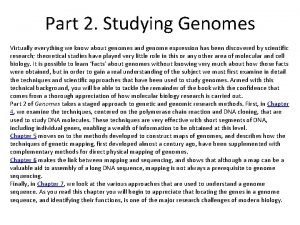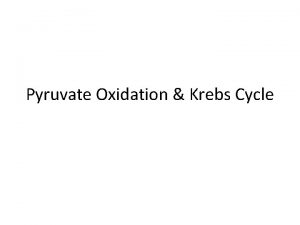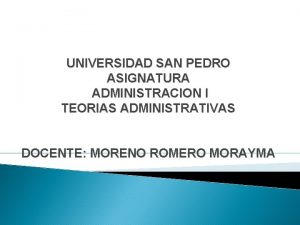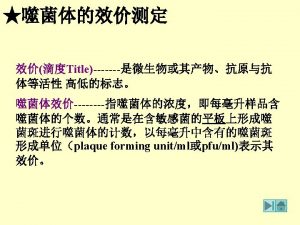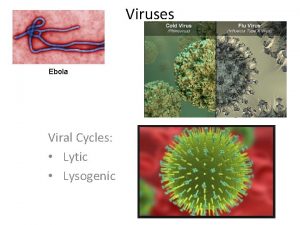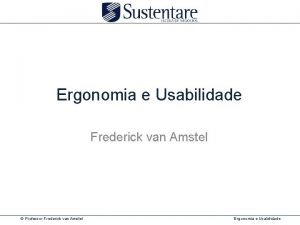DISCOVERY OF LYSOGENIC CYCLE Frederick w twort from















- Slides: 15


DISCOVERY OF LYSOGENIC CYCLE: � Frederick w. twort from the uk and Felix d’herelle from France independently discovered bacteriophage or the phenomena of a virus infected bacterium in 1915 and 1917 respectively. D’herelle a French Canadian working at the Pasteur institute in pairs hypothesized that a microbe caused lytic and lysogenic bacteria.

WHAT DOES LYSOGENIC MEAN? �A lysogen or lysogenic bacterium is a bacterial cell which can produce and transfer the ability to produce a phage. a prophage is either integrated into the host bacteria’s chromosome or more rarely exists as a stable plasmid within the host cell.

� Lysogeny or lysogenic cycle is one of two cycles of viral reproduction (the lytic being other) lysogeny is characterized by integration of the bacteriophage nucleic acid into the host bacterium genome or formation of a circular replicon in the bacterial cytoplasm.

STEPS OF LYSOGENIC CYCLE: � The following are the steps of the lysogenic cycle: I. Viral genome enters cell II. viral genome integrated into host cell genome III. Host cell DNA polymerase copies viral chromosomes IV. Cell divides and virus chromosomes are transmitted to cell daughter cells. V. Detaching of viral genome from host cells.

STAGES OF LYSOGENIC CYCLE: 1. Fusion of genetic material: lysogeny is characterized by the fusion of the viral nucleic acid with that of the host cell.

2. Replication of the prophage: The newly integrated prophage can be passed on to daughter cells during every cell division. Cells containing the prophage may replicate many times.

3. Prophage leaves host DNA: At a later point, the prophage may dissociate from the host DNA as a result the virus has entered the lytic cycle and virus practical are made by the host cells.

SUMMARY OF STAGES: � The lysogenic cycle the viral DNA gets integrated into the host’s DNA but the viral genes are not expressed the prophage is passed on to daughter cells during every cell division after some time, the prophage leaves the bacterial DNA and goes through the lytic cycle creating more viruses.

WHICH IS FASTER LYTIC OR LYSOGENIC? � The lytic cycle is a faster process for viral replication than the lysogenic cycle. why? the virus begins to replicate copies of itself until it causes the host cell to lyses meaning it bursts open and releases the new viral particles.

WHY LYSOGENIC VIRUSES ARE MORE DANGEROUS? The lysogenic cycle happens when a virus infiltrates a cell but rather than quickly hijacking its, the virus inserts its genetic material instead to the host DNA the danger in the lysogenic stage is that the more times its utilize the more infected daughter cells are produced.

WHAT HAPPEN WHEN THE VIRAL GENOME FUSES WITH THE HOST GENOME? � Fusion of the genome is known as lysogeny or the lysogenic cycle. It is part of the viral life cycle and result in many new host cells that contain the viral genome.

ADVANTAGE OF A LYSOGENIC CYCLE � Lysogeny can also be beneficial to the host bacterium the primary benefit to bacteria occurs when the integrated viral DNA contains a gene that encodes a toxin. possessionof the toxin can be advantageous to those bacteria that established an infection as part of their stragey of replication.

DIAGRAM OF LYSOGENIC CYCLE:

The lysogenic cycle is complimentary to the lytic cycle for viral entry and reproduction the lysogenic cycle is more commonly found in animal viruses.
 Frederick twort
Frederick twort Lytic and lysogenic cycle similarities
Lytic and lysogenic cycle similarities Difference between lytic and lysogenic cycle
Difference between lytic and lysogenic cycle Introduction of bacteria
Introduction of bacteria Youtube
Youtube Https://m..com/watch?v=nqecciuc7jy
Https://m..com/watch?v=nqecciuc7jy Lysogenic viruses do not
Lysogenic viruses do not Is the zika virus lytic or lysogenic
Is the zika virus lytic or lysogenic Lysogenic infection
Lysogenic infection Krebs cycle discovery
Krebs cycle discovery Pearson cellular respiration
Pearson cellular respiration Don alden adams
Don alden adams Teoria x y y de la administracion
Teoria x y y de la administracion William frederick harris
William frederick harris Miss laetitia prism
Miss laetitia prism Map of frederick douglass escape route
Map of frederick douglass escape route








